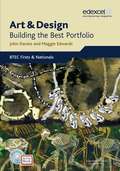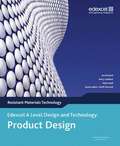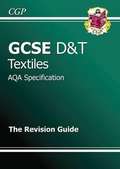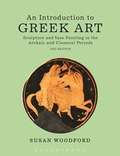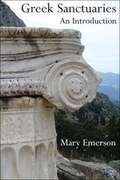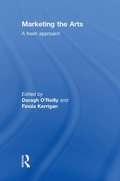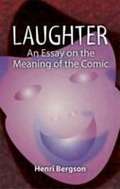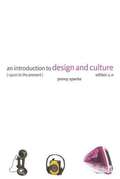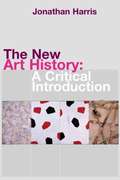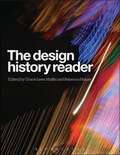- Table View
- List View
Art and Design: Building the Best Portfolio
by Maggie Edwards John DaviesAre you a BTEC First or National learner who wants to find out how to create a successful art and design portfolio? This book is a valuable resource designed to provide you with guidance and support to assist you in the process of responding to an assignment brief and building the best portfolio of work possible. nbsp; It contains a wide range of exemplar learner work, with each assignment tracked from brief through to final outcome, plus tutor commentary, learner comments, hints and tips and further resources and career guidance.
Edexcel A Level Design and Technology: Product Design (PDF)
by Jon Attwood Geoff Hancock Barry Lambert Peter NealEdexcel A Level Design and Technology: Product Design - Resistant Materials Technology has been written and produced by an expert team to support the new Edexcel Graphic Products specification for 2008. The engaging full-colour Student Book is completely matched to the new Edexcel A Level Product Design course requirements, so you can be confident that it will provide all your students need to develop the skills and understanding to succeed at AS and A2 Level. Written by experienced examiners and teachers to support the new Edexcel specification.Builds on the aspects of the current editions that teachers have told us they love - a clear match to the specification with step-by-step guidance to answering exam questions.Additional exam tips, practice questions and sample answers with comments will give students the confidence to tackle all the questions that come up in the exam.A wealth of classroom activities with structured guidance helps save teachers time.Now in full colour to bring the subject to life and help make explanations of key concepts clearer.
CGP GCSE D&T Textiles for AQA Specification - The Revision Guide
by Richard ParsonsThis book is for anyone studying AQA GCSE Textiles. Let's face it, Damp;T is pretty hard-going - you've got a whole load of technical stuff to learn on top of doing your project. nbsp; Happily this CGP book helps to take the headache out of all that learning. We've explained all the technical stuff - and drawn plenty of pictures to make the whole thing a bit clearer. Plus we've stuck in some handy hints to help make your project a winner, and some tips on exam technique. nbsp; And in true CGP style it's got some daft bits in to try and make the whole experience at least vaguely entertaining for you.
An Introduction To Greek Art: Sculpture And Vase Painting In The Archaic And Classical Periods (PDF)
by Susan WoodfordThe four centuries between the composition of the Homeric epics and the conquests of Alexander the Great witnessed an immensely creative period in Greek art, one full of experimentation and innovation. But time has taken its toll; damaged statues have lost their colour and wall paintings have been totally destroyed. And yet sympathetic study of surviving sculpture and of drawing on vases can give extraordinary insight into and appreciation of these once brilliant works This book, designed originally for students, introduces the reader to Greek sculpture and vase painting in the critical period from the eighth to the fourth centuries BC. The works discussed are generously illustrated and lucidly analysed to give a vivid picture of the splendor of Greek art. The up-dated second edition includes a new chapter examining art in Greek society, a timeline to help relate artistic development to historical events, an explanation of how dates BC are arrived at, a brief overview of Greek temple plans and a further reading list of recent books. This clear, approachable and rigorous introduction makes the beauty of Greek art more readily accessible and comprehensible, balancing description with interpretation and illustration, and is an invaluable tool to help develop insight, appreciation and comprehension.
Greek Sanctuaries: An Introduction (PDF)
by Mary Emerson"Greek Sanctuaries" offers a good basic understanding of ancient Greek sanctuary sites and temple architecture. Assuming no prior knowledge, it introduces the reader to a select number of sites and temples in some depth, explaining technical terms along the way. The author has borne in mind the needs of students at sixth-form and university level, as well as the general reader, and has covered some of the core buildings and sanctuaries usually chosen for study owing to their social importance and aesthetic excellence, including the Athenian Acropolis, Delphi and Olympia. The book explores some of the aesthetic concepts behind Greek architectural design, as well as looking in some detail at the buildings and their decoration. It also investigates their importance within the culture of the time, asking such questions as: What were temples for? How do sanctuary buildings relate to each other and to the space where they are set? What was the purpose of architectural sculpture? The accessible text will inspire the visitor to Greece and equip the student of Greek architecture for further study.
Marketing The Arts: A Fresh Approach
by Daragh O'Reilly Finola KerriganIn recent years, there have been significant shifts in arts marketing, both as a practice and an academic discipline. The relationship between art and the market is increasingly complex and dynamic, requiring a transformation in the way the arts are marketed. Marketing the Arts argues that arts marketing is not about the simple application of mainstream managerial marketing to the arts. With contributions from international scholars of marketing and consumer studies, this book engages directly with a range of contemporary themes, including: The importance of arts consumption and its social dimensions The importance of the aesthetic experience itself, and how to research it Arts policy development The art versus commerce debate The role of the arts marketer as market-maker The artist as brand or entrepreneur This exciting new book covers topics as diverse as Damien Hirst's 'For the Love of God', Liverpool's brand makeover, Manga scanlation, Gob Squad, Surrealism, Bluegrass music, Miles Davis and Andy Warhol, and is sure to enthuse students and enlighten practitioners. 0203855078 ISBN 13: 9780415496858 (hbk) ISBN 13: 9780415496865 (pbk) ISBN 13: 9780203855072 (ebk) ISBN 10: 0415496853 (hbk) ISBN 10: 0415496861 (pbk) ISBN 10: 0203855078 (ebk)
Marketing The Arts: A Fresh Approach (PDF)
by Daragh O'Reilly Finola KerriganIn recent years, there have been significant shifts in arts marketing, both as a practice and an academic discipline. The relationship between art and the market is increasingly complex and dynamic, requiring a transformation in the way the arts are marketed. Marketing the Arts argues that arts marketing is not about the simple application of mainstream managerial marketing to the arts. With contributions from international scholars of marketing and consumer studies, this book engages directly with a range of contemporary themes, including: The importance of arts consumption and its social dimensions The importance of the aesthetic experience itself, and how to research it Arts policy development The art versus commerce debate The role of the arts marketer as market-maker The artist as brand or entrepreneur This exciting new book covers topics as diverse as Damien Hirst's 'For the Love of God', Liverpool's brand makeover, Manga scanlation, Gob Squad, Surrealism, Bluegrass music, Miles Davis and Andy Warhol, and is sure to enthuse students and enlighten practitioners. 9780415496858 (hbk) 9780415496865 (pbk) 9780203855072 (ebk) 0415496853 (hbk) 0415496861 (pbk) 0203855078 (ebk)
Laughter: An Essay on the Meaning of the Comic
by Henri BergsonIn this great philosophical essay, Henri Bergson explores why people laugh and what laughter means. Written at the turn of the twentieth century, Laughter explores what it is in language that makes a joke funny and what it is in us that makes us laugh. One of the functions of humor, according to Bergson, is to help us retain our humanity during an age of mechanization. Like other philosophers, novelists, poets, and humorists of his era, Bergson was concerned with the duality of man and machine. His belief in life as a vital impulse, indefinable by reason alone, informs his perception of comedy as the relief we experience upon distancing ourselves from the mechanistic and materialistic. "A situation is always comic," Bergson notes, "if it participates simultaneously in two series of events which are absolutely independent of each other, and if it can be interpreted in two quite different meanings. " The philosopher's thought-provoking insights (e. g. , "It seems that laughter needs an echo. Our laughter is always the laughter of a group. ") keep this work ever-relevant as a thesis on the principles of humor.
Letters to His Son, Complete / On the Fine Art of Becoming a Man of the World and a Gentleman
by Earl of Philip Dormer Stanhope ChesterfieldEarl of Philip Dormer Stanhope Chesterfield was an 18th century British aristocrat best known for his wit and for being a man of letters. His works offer a great insight into what life was like during the time period in England.
Literary Taste: How to Form It / With Detailed Instructions for Collecting a Complete Library of English Literature
by Arnold BennettAt the beginning a misconception must be removed from the path. Many people, if not most, look on literary taste as an elegant accomplishment, by acquiring which they will complete themselves, and make themselves finally fit as members of a correct society. They are secretly ashamed of their ignorance of literature, in the same way as they would be ashamed of their ignorance of etiquette at a high entertainment, or of their inability to ride a horse if suddenly called upon to do so. There are certain things that a man ought to know, or to know about, and literature is one of them :such is their idea.
Die mehreren Wehmüller und ungarischen Nationalgesichter
by Clemens BrentanoThe traveling painter Wehmüller invented the art of Schnellporträtierens. He paints the people before he sees them. Clemens Brentano has a firework in his first published in 1817 narrative - sparked joke - knowledge-creating. Motifs and storylines are funny and profoundly interwoven. illustrate the drawings by Karl-Georg Hirsch and densify the bizarre and grotesque scenes of the narrative; Hans Magnus Enzensberger described the contemporary historical and philosophical background of this satirical piece Cabinet.
An Introduction To Design And Culture: 1900 To The Present (PDF)
by Penny SparkeNow in a completely new and updated edition, this introduction to the development of modern (and postmodern) design is ideal for undergraduate students. Divided into four parts, the book covers the major periods in design culture since the start of the twentieth century, beginning by examining the formative years 1900-1914. Two sections on design and modernity explore the periods 1915-1939 and 1939-1969, and a completely new section, design and postmodernity, covers 1970 to the present. New to this edition are: key discussions on postmodernism and design the alliance between technology and design the relationship between identity and design. Drawing on a wealth of mass-produced artifacts, images and environments including sewing machines, cars, televisions, clothes, electronic and branded goods and exhibitions, Sparke shows how design has helped to shape and reflect our social and cultural development.
The New Art History: A Critical Introduction
by Jonathan HarrisThe New Art History provides a comprehensive introduction to the fundamental changes which have occurred in both the institutions and practice of art history over the last thirty years. Jonathan Harris examines and accounts for the new approaches to the study of art which have been grouped loosely under the term 'the new art history'. He distinguishes between these and earlier forms of 'radical' or 'critical' analysis, explores the influence of other disciplines and traditions on art history, and relates art historical ideas and values to social change. Structured around an examination of key texts by major contemporary critics, including Tim Clarke, Griselda Pollock, Fred Orton, Albert Boime, Alan Wallach and Laura Mulvey, each chapter discusses a key moment in the discipline of art history, tracing the development and interaction of Marxist, feminist and psychoanalytic critical theories. Individual chapters include: * Capitalist Modernity, the Nation-State and Visual Representation * Feminism, Art, and Art History * Subjects, Identities and Visual Ideology * Structures and Meanings in Art and Society * The Representation of Sexuality
The Design History Reader (PDF)
by Grace Lees-Maffei Rebecca HouzeThe first systematic and comprehensive reader on Design History, this book examines the role of design and designed objects within social and cultural history. Extracts range from the 18th century, when design and manufacture separated, to the present day. Drawn from scholarly and polemical books, research articles, exhibition catalogues, and magazines, the extracts are placed in themed sections, with each section separately introduced and each concluded with an annotated guide to further reading. Covering both primary texts (such as the writings of designers and design reformers) and secondary texts (in the form of key works of design history), the reader provides an essential resource for understanding the history of design, the development of the discipline, and contemporary issues in design history and practice. Selected authors: Judy Attfield, Jeremy Aynsley, Rayner Banham, Roland Barthes, Jean Baudrillard, Walter Benjamin, Pierre Bourdieu, Christopher Breward, Denise Scott Brown, Ruth Schwarz Cowan, Clive Dilnot, Buckminster Fuller, Paul Greenhalgh, Dick Hebdige, Steven Heller, John Heskett, Pat Kirkham, Adolf Loos, Victor Margolin, Karl Marx, Jeffrey Meikle, William Morris, Gillian Naylor, Victor Papanek, Nikolaus Pevsner, John Ruskin, Adam Smith, Penny Sparke, John Styles, Nancy Troy, Thorstein Veblen, Robert Venturi, John Walker, Frank Lloyd Wright.
Clown riding a 'Giraffe' unicycle (Large Print)
This is an image of a circus clown riding a one-wheeled cycle in the middle of the page. He is facing to the right with only one eye visible. There is a locator dot shown, which will be at the top left of the page when the image is the right way up. At the top centre of the page is the clown's little bowler hat sitting on his long hair. Just to the right of this is his face seen from the side with one eye, his comedy red nose and his big wide mouth. His arms are thrown out wide to the left and right from his right-facing body and down the page from this is his bottom sitting on the seat of the unicycle. Down the page again is the frame of the cycle with the clown's legs to the left and right and his feet in enormous clown boots on the pedals of the machine. His foot to the left is behind the arm of the pedal. At the bottom of the page is the cycle's wheel, connected to the pedals by a chain.
Clown riding a 'Giraffe' unicycle (UEB Contracted)
This is an image of a circus clown riding a one-wheeled cycle in the middle of the page. He is facing to the right with only one eye visible. There is a locator dot shown, which will be at the top left of the page when the image is the right way up. At the top centre of the page is the clown's little bowler hat sitting on his long hair. Just to the right of this is his face seen from the side with one eye, his comedy red nose and his big wide mouth. His arms are thrown out wide to the left and right from his right-facing body and down the page from this is his bottom sitting on the seat of the unicycle. Down the page again is the frame of the cycle with the clown's legs to the left and right and his feet in enormous clown boots on the pedals of the machine. His foot to the left is behind the arm of the pedal. At the bottom of the page is the cycle's wheel, connected to the pedals by a chain.
Clown riding a 'Giraffe' unicycle (UEB uncontracted)
This is an image of a circus clown riding a one-wheeled cycle in the middle of the page. He is facing to the right with only one eye visible. There is a locator dot shown, which will be at the top left of the page when the image is the right way up. At the top centre of the page is the clown's little bowler hat sitting on his long hair. Just to the right of this is his face seen from the side with one eye, his comedy red nose and his big wide mouth. His arms are thrown out wide to the left and right from his right-facing body and down the page from this is his bottom sitting on the seat of the unicycle. Down the page again is the frame of the cycle with the clown's legs to the left and right and his feet in enormous clown boots on the pedals of the machine. His foot to the left is behind the arm of the pedal. At the bottom of the page is the cycle's wheel, connected to the pedals by a chain.
Circus Ringmaster (UEB uncontracted)
This is a picture of the circus ringmaster in his traditional costume holding a whip. He is standing facing forward in the middle of the page so all his limbs and facial features can be seen. There is a locator dot shown, which will be at the top left of the page when the image is the right way up. At the top of the page is the ringmaster's tall top hat with some wisps of hair sticking out. Just down the page is his face with two eyes, nose and mouth visible. Down again are his bow tie, shirt and three-buttoned waistcoat. To either side are the lapels of his long frock coat, which comes down to his waist at the front and to his knees at the back. It has two buttons to the left of the waistcoat buttons. His arms are held out wide, the one to the right is holding the whip. Further down the page the ringmaster wears long trousers tucked into his long leather riding boots.
Circus balancing act (UEB uncontracted)
This page shows two circus acrobats. The first acrobat stands facing forward at the bottom of the page, while the second one balances upside down, on one hand, on the first acrobat's head. There is a locator dot shown, which will be at the top left of the page when the image is the right way up. At the bottom of the page are the feet of the first acrobat, who is supporting the second acrobat. Above these are his legs wearing tights, and his bare chest. Up again are his strong shoulders with his arms held out wide to the left and right, to make his stance more stable. He wears bands on his wrists to reduce the risk of injury. His head is bearing the weight of the second acrobat further up the page who is balancing on one hand. The second acrobat wears a band on his wrist, and his arm continues vertically up the page. To the right of this his upside-down head can be found, and to the right again is his other arm wearing a wristband. Up the page from his head are his bare chest and his two legs stretched out to the left and right to help him balance.
Circus Ringmaster (Large Print)
This is a picture of the circus ringmaster in his traditional costume holding a whip. He is standing facing forward in the middle of the page so all his limbs and facial features can be seen. There is a locator dot shown, which will be at the top left of the page when the image is the right way up. At the top of the page is the ringmaster's tall top hat with some wisps of hair sticking out. Just down the page is his face with two eyes, nose and mouth visible. Down again are his bow tie, shirt and three-buttoned waistcoat. To either side are the lapels of his long frock coat, which comes down to his waist at the front and to his knees at the back. It has two buttons to the left of the waistcoat buttons. His arms are held out wide, the one to the right is holding the whip. Further down the page the ringmaster wears long trousers tucked into his long leather riding boots.
Circus balancing act (Large Print)
This page shows two circus acrobats. The first acrobat stands facing forward at the bottom of the page, while the second one balances upside down, on one hand, on the first acrobat's head. There is a locator dot shown, which will be at the top left of the page when the image is the right way up. At the bottom of the page are the feet of the first acrobat, who is supporting the second acrobat. Above these are his legs wearing tights, and his bare chest. Up again are his strong shoulders with his arms held out wide to the left and right, to make his stance more stable. He wears bands on his wrists to reduce the risk of injury. His head is bearing the weight of the second acrobat further up the page who is balancing on one hand. The second acrobat wears a band on his wrist, and his arm continues vertically up the page. To the right of this his upside-down head can be found, and to the right again is his other arm wearing a wristband. Up the page from his head are his bare chest and his two legs stretched out to the left and right to help him balance.
Circus Ringmaster (UEB Contracted)
This is a picture of the circus ringmaster in his traditional costume holding a whip. He is standing facing forward in the middle of the page so all his limbs and facial features can be seen. There is a locator dot shown, which will be at the top left of the page when the image is the right way up. At the top of the page is the ringmaster's tall top hat with some wisps of hair sticking out. Just down the page is his face with two eyes, nose and mouth visible. Down again are his bow tie, shirt and three-buttoned waistcoat. To either side are the lapels of his long frock coat, which comes down to his waist at the front and to his knees at the back. It has two buttons to the left of the waistcoat buttons. His arms are held out wide, the one to the right is holding the whip. Further down the page the ringmaster wears long trousers tucked into his long leather riding boots.
Circus balancing act (UEB Contracted)
This page shows two circus acrobats. The first acrobat stands facing forward at the bottom of the page, while the second one balances upside down, on one hand, on the first acrobat's head. There is a locator dot shown, which will be at the top left of the page when the image is the right way up. At the bottom of the page are the feet of the first acrobat, who is supporting the second acrobat. Above these are his legs wearing tights, and his bare chest. Up again are his strong shoulders with his arms held out wide to the left and right, to make his stance more stable. He wears bands on his wrists to reduce the risk of injury. His head is bearing the weight of the second acrobat further up the page who is balancing on one hand. The second acrobat wears a band on his wrist, and his arm continues vertically up the page. To the right of this his upside-down head can be found, and to the right again is his other arm wearing a wristband. Up the page from his head are his bare chest and his two legs stretched out to the left and right to help him balance.
Empire State Building, USA (Large Print)
This image shows the 381 metre tall Empire State Building surrounded by a dashed line image border. The base of the building is on the bottom of the page. There is a locator dot shown, which will be at the top left of the page when the image is the right way up. At the bottom of the page two dots can be found, these represent the large entrance doorways. They show how tall the building is. Up from this the building stretches up, becoming narrower towards the top. At the top of the image, the building steps dramatically inwards, becoming narrower, finally reaching the broadcasting antenna.
Empire State Building, USA (UEB Contracted)
This image shows the 381 metre tall Empire State Building surrounded by a dashed line image border. The base of the building is on the bottom of the page. There is a locator dot shown, which will be at the top left of the page when the image is the right way up. At the bottom of the page two dots can be found, these represent the large entrance doorways. They show how tall the building is. Up from this the building stretches up, becoming narrower towards the top. At the top of the image, the building steps dramatically inwards, becoming narrower, finally reaching the broadcasting antenna.
